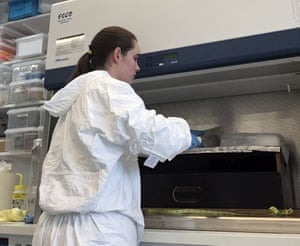https://www.theguardian.com/world/2020/apr/22/microplastics-found-for-first-time-in-antarctic-ice-where-krill-source-food
Microplastics found for first time in Antarctic ice where krill source food
Researchers at University of Tasmania find 14 different kinds of plastic smaller than 5mm in an ice core from 2009
Small pieces of plastic have been detected in sea ice in Antarctica for what scientists believe is the first time.
Microplastics have previously been discovered in Antarctica’s surface waters, sediment and in snow, but the new discovery could mean the region’s krill – which feed on algae from sea ice – may be more exposed to the plastic.
Some 96 pieces of plastic less than 5mm wide were found in an analysis of the ice core that was drilled in 2009 and had been stored in Hobart, Tasmania.
The study found 14 different kinds of plastic, and on average about 12 pieces of plastic were found per litre of water.
Anna Kelly from the Institute for Marine and Antarctic Studies at the University of Tasmania, was the lead author of the study, published in the Marine Pollution Bulletin.
Kelly said: “The remoteness of the Southern Ocean has not been enough to protect it from plastic pollution, which is now pervasive across the world’s oceans.”
She said the concentrations found in the Antarctic ice core were slightly lower than a previous study that found microplastics in Arctic sea ice.
She said: “The microplastic polymers in our ice core were larger than those in the Arctic, which may indicate local pollution sources because the plastic has less time to break down into smaller fibres than if transported long distances on ocean currents.
“Local sources could include clothing and equipment used by tourists and researchers, while the fact that we also identified fibres of varnish and plastics commonly used in the fishing industry suggests a maritime source.”
Assoc Prof Delphine Lannuzel, also of IMAS and a co-author of the study, is a sea ice chemist who helped drill the core about two kilometres from the coast in 2009.
The core was taken from “fast ice” – ice that forms around the coast and is not mobile, unlike pack ice. The core analysed was about 1.1m long and about 14cm wide.
Lannuzel said when researchers analysed the core, they found the plastics were surrounded by algae that had grown in the ice.
“Sea ice is habitat for key foraging species,” she said. “Krill defines everything else in the food chain and it relies on sea ice algae to grow.
“When you think now that sea ice algae is associated to plastics, you can think about the bioaccumulation of the plastics in krill and in whales.”
There was a higher concentration of plastic particles at the bottom of the ice core.
She said a lot of study was still needed to understand the impact of plastics on species relying on the sea ice.
She said it was not known if the toxicity of plastics was affected by the processes in the guts of krill and other species, including whales that feed on the krill.
Kelly said: “Rather than sinking to the deep ocean, the entrapment of microplastics in Antarctic sea ice allows them to persist for longer near the sea surface.
Kelly said krill was “a keystone species in Southern Ocean ecosystems” and was vital for marine predators higher up the food chain.
“It is worth noting that plastic contamination of West Antarctic sea ice may be even greater than in our ice core from the east, as the Antarctic peninsula hosts the bulk of the continent’s tourism, research stations and marine traffic.”
We've got an announcement …
… on our progress as an organisation. In service of the escalating climate emergency, we have made an important decision – to renounce fossil fuel advertising, becoming the first major global news organisation to institute an outright ban on taking money from companies that extract fossil fuels.
In October we outlined our pledge: that the Guardian will give global heating, wildlife extinction and pollution the urgent attention and prominence they demand. This resonated with so many readers around the world. We promise to update you on the steps we take to hold ourselves accountable at this defining point in our lifetimes. With climate misinformation rife, and never more dangerous than now, the Guardian's accurate, authoritative reporting is vital – and we will not stay quiet.
We chose a different approach: to keep Guardian journalism open for all. We don't have a paywall because we believe everyone deserves access to factual information, regardless of where they live or what they can afford to pay.
Our editorial independence means we are free to investigate and challenge inaction by those in power. We will inform our readers about threats to the environment based on scientific facts, not driven by commercial or political interests. And we have made several important changes to our style guide to ensure the language we use accurately reflects the environmental emergency.
The Guardian believes that the problems we face on the climate crisis are systemic and that fundamental societal change is needed. We will keep reporting on the efforts of individuals and communities around the world who are fearlessly taking a stand for future generations and the preservation of human life on earth. We want their stories to inspire hope.
We hope you will consider supporting us today. We need your support to keep delivering quality journalism that’s open and independent. Every reader contribution, however big or small, is so valuable. Support the Guardian from as little as $1 – and it only takes a minute. Thank you.


沒有留言:
張貼留言